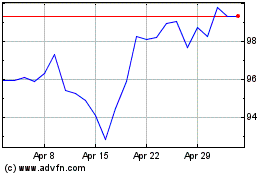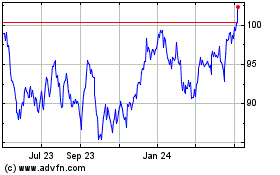Mandates, Not Market Prices, Likely to Keep U.S. Solar Growing
February 20 2018 - 7:29AM
Dow Jones News
By Erin Ailworth
Government mandates should keep U.S. solar power growing,
despite new Trump administration tariffs on imported solar panels
that are poised to raise prices.
While the tariffs may slow the rate of solar expansion, local
and state policies requiring utilities to procure renewable energy
will continue to help create a baseline market for solar power,
particularly for large, utility-scale projects.
New York, for instance, has called for three gigawatts of solar
capacity to be installed in the state by 2023, roughly three times
the amount installed at the end of 2017.
The Trump administration tariffs -- 30% in the first year,
declining to 15% by the fourth -- will raise the price of
foreign-made solar panels and cells. But technological improvements
and cost savings in other areas are expected to help the industry
at least partially offset the increases, utility executives and
analysts say.
"We are still bullish that solar prices will continue to come
down -- maybe not at the pace they've been coming down," said
Robert Caldwell, president of Duke Energy Corp.'s renewable and
distributed energy technology businesses.
Duke says it currently has about 2.5 gigawatts of solar energy
generating capacity in North Carolina and South Carolina, and has
plans to build or procure more than three gigawatts in the next
five years.
To prepare for the tariffs, solar developers like NextEra Energy
Inc. and Cypress Creek Renewables have been stockpiling solar
panels.
NextEra Chief Executive James Robo recently told analysts on a
conference call that his company already has purchased all the
panels its needs to build in 2018 and 2019, as well as the panels
for "a significant portion of our 2020 build."
Cypress Creek Chief Executive Matthew McGovern said his company
also pre-purchased many of the panels it will need this year, and
has been pushing projects out to the later years of the tariff,
when the trade protection will be less stringent, or beyond.
"We're trying to do everything we can to keep projects from
dying out," he said.
U.S. solar costs have fallen in recent years, partly due to a
flood of cheap, foreign-made solar panels and cells, the component
that converts sunlight to energy.
A residential solar installation now costs $2.93 a watt on
average, compared with $6.61 in 2010, according to data from GTM
Research, which tracks trends in renewable energy. In the same time
frame, the price of a large, utility-scale solar system has fallen
by nearly 70%, to $1.11 a watt from $3.58 a watt on average,
according to GTM.
GTM forecasts the price of solar panels will rise 10 cents a
watt on average in the first year of the new Trump trade
protections. It predicts demand -- already down after a record
2016, when installers raced to take advantage of tax credits --
will drop by some 7.6 gigawatts between now and 2022 compared with
previous forecasts. However, GTM expects solar should start to rise
again and begin approaching 2016 levels by the end of that time
frame.
GTM predicts utility-scale solar projects will take the hardest
hit because they will be less competitive compared with other forms
of energy generation, including wind turbines and natural gas power
plants.
Government mandates, however, are expected to blunt the losses.
Several states have set aggressive renewable energy goals,
including California and New York, which are aiming to procure half
their electricity from renewable resources by 2030.
(END) Dow Jones Newswires
February 20, 2018 07:14 ET (12:14 GMT)
Copyright (c) 2018 Dow Jones & Company, Inc.
Duke Energy (NYSE:DUK)
Historical Stock Chart
From Mar 2024 to Apr 2024

Duke Energy (NYSE:DUK)
Historical Stock Chart
From Apr 2023 to Apr 2024
